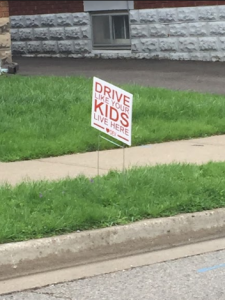The smell of honeysuckle and lilac, the sight of beautiful magnolia blossoms that sparkle and fade all too fast and the sound of robins greeting each sunrise with joyful chirps are all welcomed signs of spring. One of the other sure signs of spring in the Forest City is the numerous construction projects which sat dormant during the winter but come alive as the snow melts and the days become longer.
 Last week, as a result of one of these many construction projects, I dutifully followed the detour signs through a subdivision close to the Education Center. Along with the make shift speed bumps, I noticed this sign “Drive Like Your Kids Live Here” on many of the front lawns. I immediately slowed down and found myself taking extra care in checking my mirrors and blind spots. I watched for unexpected distractions such as stray balls rolling onto the road as a result of a missed shot in a driveway hockey game or all too focused dandelion pickers unaware of their surroundings and any potential dangers.
Last week, as a result of one of these many construction projects, I dutifully followed the detour signs through a subdivision close to the Education Center. Along with the make shift speed bumps, I noticed this sign “Drive Like Your Kids Live Here” on many of the front lawns. I immediately slowed down and found myself taking extra care in checking my mirrors and blind spots. I watched for unexpected distractions such as stray balls rolling onto the road as a result of a missed shot in a driveway hockey game or all too focused dandelion pickers unaware of their surroundings and any potential dangers.
I couldn’t help but wonder what would happen if we took that same sentiment and transferred it to our schools. What if on all of our schools signs we professed that we “Teach Like Our Own Kids Go Here”.
I recall a time when I overheard a teacher complain that at her daughter’s school no one was stepping up to coach one of the sports teams. Yet that same staff member wasn’t volunteering any of her time at the school that she worked at to do any coaching. I found it rather ironic.
When we think about the classroom environment that we want for our own children, do we do our best as educators to replicate that for our students? Do we greet our students at the door every morning and let them know that we are so glad that they are here.
When there is an issue with another student, do we take the time to investigate and help problem solve the situation with care, kindness and fairness?
Do we provide choice in our tasks and honour and embrace student voice because we truly believe that our students have something worthwhile to say? Do we take the time to read what our students are reading so that we can suggest that “just right” book and watch their faces light up because they know that we care enough to go the extra mile?
 Do we provide our students with multiple (differentiated) ways to demonstrate their learning, because just like our own children are individuals (I often wonder how my own three children, who had the exact same environment as children have grown into such individuals with their own set of unique strengths) our students have their own backpack of strengths.
Do we provide our students with multiple (differentiated) ways to demonstrate their learning, because just like our own children are individuals (I often wonder how my own three children, who had the exact same environment as children have grown into such individuals with their own set of unique strengths) our students have their own backpack of strengths.
When assigning multiple tasks to be completed at home, do we as educators stop and contemplate the impact that our “homework” will have on our families. How would we feel as a parent of a student in our class, managing night time routines which include assigned homework?
Over the years, I’ve been fortunate that many of my own children’s teachers where incredible and I’ve worked alongside of educators who “teach like their own children go here”.
But what If we ALL taught like our children were in our class, can you imagine the impact?
Come write with me…..

I wonder if teaching is a place where we create a sense of belonging for children and our communities. In the world of teaching and learning is there a space where educators and children thrive as they learn to just be? I am teased for always asking, where do you see yourself in the curriculum? Can you just be?
This may sound spiritual if you will but as I look back on my career or contribution to learning (notice I didn’t say teaching) I wonder if the space of servitude exists for those who truly believe that children and teaching is a space and place to learn from and with one another. If we believe that children in relation to educators are capable and competent then we will bring what the child needs in relation understanding their place in our community. If a child feels disconnected from their educator or school, then will they see themselves in that school? How do we create a sense of belonging when an educator does not feel as though they are connected to the child? The whole child.
Teaching is not about 9-3:30. It s about creating a space and place where children and adults come to learn from and with one another. Creating a space of joyfulness and learning at the same time. It’s about hearing the voices of children as democratic citizens. Hearing is more than listening. It’s watching. It’s feeling the joy and tears of the children and communities where we invest ourselves as educators and learners. It’s about being with others as we serve.
For me teaching was about learning. It was and will always be a place I call home.
I think over the years of having 5 kids in school we experienced both ends of the spectrum. Teachers who taught, just as you said – “As if every child were there own” and then those who actually gave the distinct impression they didn’t like children. I think some were taking to heart that old saying, “Don’t smile in September so you can enjoy June!” But they didn’t seem to
be enjoying any month. Maybe it was just their style of classroom management. Keep that separation very distant between teacher and student. I don’t know. But one teacher that stuck out for us was one we all know so well even now. Rose Walton taught our kids in JKSK and what a great experience she gave each child in her class. She truly taught as if every child were her own. And all these years later we still remember and are thankful.
When I started coaching 4 years ago, my oldest was just starting Grade 1 and my youngest was starting JK. Now that they are in Grades 4 and 2 and soon 5 and 3, I know that as a parent, I’ve gained knowledge that will influence my teacher choices in the fall. My attitude towards homework for instance, has drastically changed! It will be interesting to see what else might be affected… your post has me reflecting on that!
Each student who walks through the door is someones everything. We have to treat each one like the gem they are. If only this were the case everywhere – What would we see?
I know I see kids who are excited to come to school. I see kids who let their guard down and show their emotions; who try new things and share their ideas in a way that fits their needs. I see kids who feel cared for and know that I want what is best for them. I have students accidentally call me “mom”. I have students who tell me often that I have 31 children, not just my own 3 at home.
What I have also experienced with that approach is that it is so hard to say “no” to the kids. I say “yes” far to often and get over committed to things. I do it because of te kids and wanting them to have experiences that my own children do not. I struggle when I need to be away and often do not take the days I need because I know that my “kids” do not do well when I am not there.
The relationships we build with our students when we see them as our own are so impactful – not only for our students, but for us as teachers too. It also can’t stop at our classroom door. If we truly want to impact our students all teachers in a school need to look at all students as if they were our “own”. This way we build a stronger sense of community. We build support and encouragement for students and for ourselves as adult learners.
If only this was the reality in more places – What would we see?